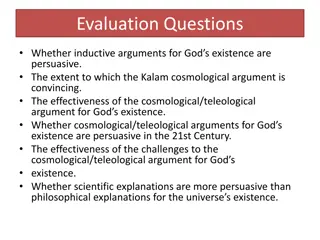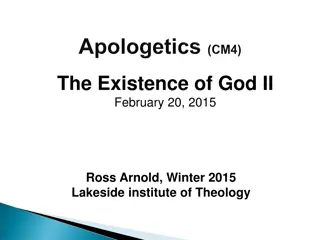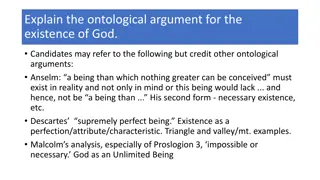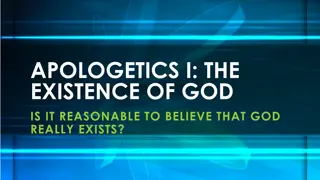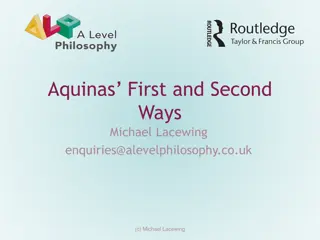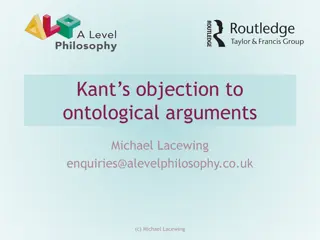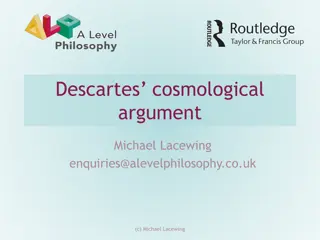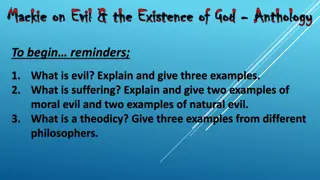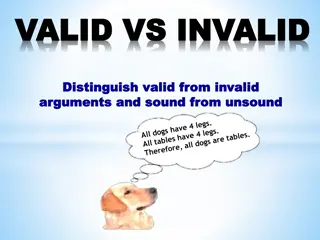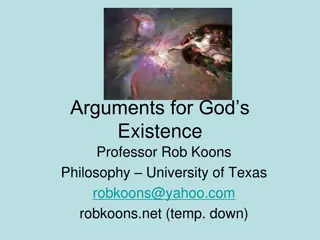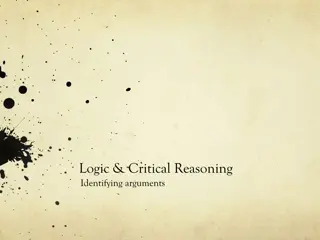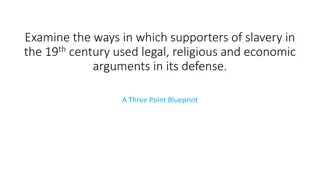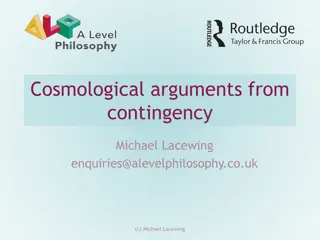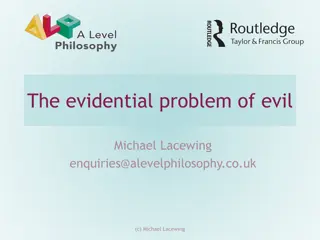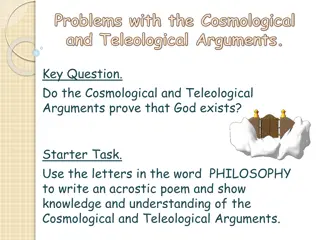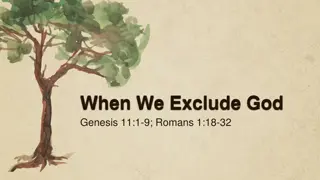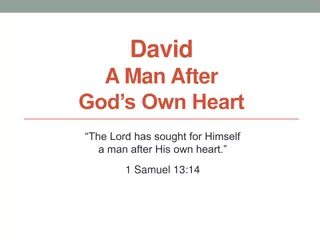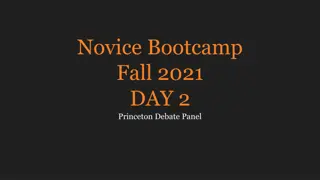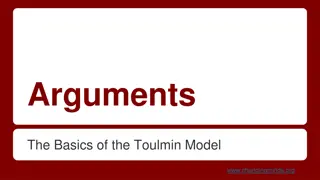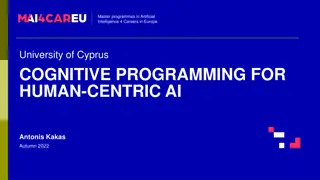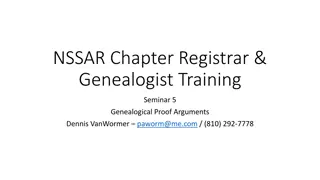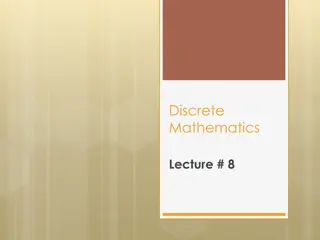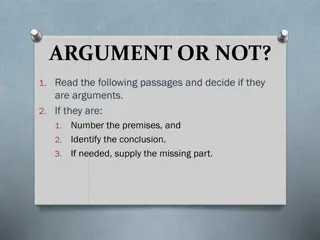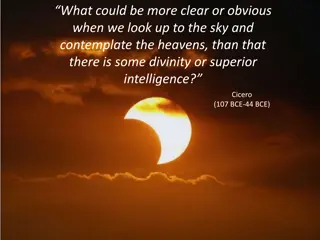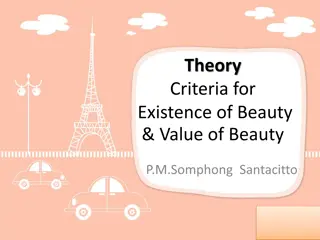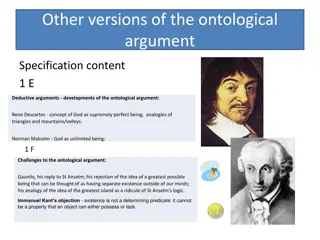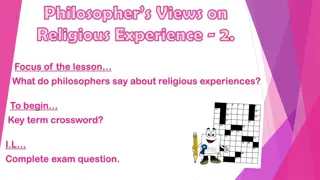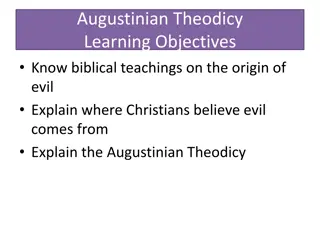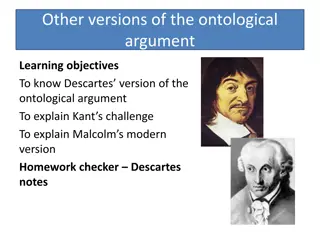Comparison of Arguments for the Existence of God
The comparison explores the Cosmological, Teleological, and Ontological arguments for the existence of God. It delves into the similarities and differences between key proponents such as Aquinas, Paley, William Lane Craig, and Tennant. Each argument is examined based on its form, empirical evidence, focus on probability, and the analogies used to support the claims. The Venn diagrams provided aid in visualizing the overlaps and distinctions within each argument.
Download Presentation

Please find below an Image/Link to download the presentation.
The content on the website is provided AS IS for your information and personal use only. It may not be sold, licensed, or shared on other websites without obtaining consent from the author. Download presentation by click this link. If you encounter any issues during the download, it is possible that the publisher has removed the file from their server.
E N D
Presentation Transcript
AO1 Comparison questions 1 Arguments for the existence of God Cosmological Teleological Ontological
Task: Complete the Venn diagram by considering the similarities and differences between the Cosmological Arguments. Use: Booklet 1 Aquinas William lane Craig
Task: Complete the Venn diagram by considering the similarities and differences between the three Teleological Arguments. Use: http://resource.downl oad.wjec.co.uk.s3.am azonaws.com/vtc/201 5-16/15- 16_15/eng/argument s-for-existence-of- god/03-teleological- argument/02-three- forms-of-the- argument.html Aquinas Paley Tennant
Task: Complete the Venn diagram by considering the similarities and differences between the three Ontological Arguments. Use: Eduqas summary Anselm Descartes Malcolm
1. (a) Compare Aquinas' and Paley's forms of the teleological argument. Both Aquinas and Paley s arguments are inductive in form and are based on empirical evidence. Both Aquinas and Paley s arguments are about probability rather than proof. Aquinas Fifth way From the governance of the world focusses on the concept that beings that lack intelligence are incapable of moving with any purpose on their own yet the observations of natural bodies seems to suggest that this is exactly what happens. Thus, for Aquinas, the focus is on the fact that non- intelligent matter achieves a purpose/end, which implies an intelligent being directing non-intelligent matter. His view of the universe is influenced by Aristotle. In contrast, Paley s understanding of the universe is different. He argues for the universe being like a complex machine that required an intelligent machine maker. He focusses on analogy with manufactured machines (pocket watch). Analogous effects have analogous causes, and we know that intelligence is the cause of a manufactured machine, so as the universe is like a manufactured machine, it demands an intelligent designer. Both Aquinas and Paley use an illustration. Aquinas - the archer is the guiding intelligence that allows the arrow, as the non-intelligent object (equivalent to the natural body ), to achieve its telos (to hit the target). Paley s Watch analogy the idea that a mechanism with intricate and complex parts all put together in order to achieve a purpose which is in itself complex is analogous to the workings of the universe and therefore suggests that as the watch needs a watchmaker so the universe likewise needs a designing creator. The argument is further extended by reference to natural phenomena structure of human eye, structure of bird s wings - these additional pieces of evidence are further proof that the universe is not the result of chance, but of deliberate, careful and intelligent, thought.
2. (a) Compare Paley's and Tennant's forms of the teleological argument. Both Paley s and Tennant s arguments are inductive in form and are based on empirical evidence. Both Paley s and Tennant s arguments are about probability rather than proof. Paley argues for the universe being like a complex machine that required an intelligent machine maker. He focusses on analogy with manufactured machines (pocket watch). Analogous effects have analogous causes, and we know that intelligence is the cause of a manufactured machine, so as the universe is like a manufactured machine, it demands an intelligent designer. Paley s Watch analogy the idea that a mechanism with intricate and complex parts all put together in order to achieve a purpose which is in itself complex is analogous to the workings of the universe and therefore suggests that as the watch needs a watchmaker so the universe likewise needs a designing creator; the argument is further extended by reference to natural phenomena structure of human eye, structure of bird s wings. These additional pieces of evidence are further proof that the universe is not the result of chance, but of deliberate, careful and intelligent thought. In contrast, Tennant focusses on the Anthropic principle (cosmos developed for intelligent life) the identification through Tennant of the three principles that underline deliberate design (structure of natural world in providing the elements necessary to sustain intelligent human life, the fact that the workings of the world can be discovered and the fact that the universe led to the development of intelligent human life). Tennant also argues for the Aesthetic argument Tennant sassertion that the beauty in the world and humankind s natural inclination to enjoy art, music and literature are the result of deliberate design by a benevolent designer who wanted humankind not only to exist, but to enjoy and appreciate their existence. Hence, Paley focusses more on how the universe works like a machine, whilst Tennant focusses more on the end product its suitability for intelligent human life.
Explain the difference between Anselms argument and Descartes argument Anselm has no theory of absolute objective greatness. It is more that existing in reality is greater than existing as an idea. There is no concept of total greatness of which existence is an aspect. Descartes does have a theory of absolute objective perfection. Existence is an aspect of the concept of total perfection.
Task: Complete the Venn diagram by considering the similarities and differences between the three Ontological Arguments. Use: Eduqas summary Anselm Descartes Malcolm
The ontological argument In what ways are they similar? They all have in common the fact that they seek to prove the existence of God deductive the conclusion necessarily follows from the premises. If the premises are true then the conclusion must follow analytical the truth (or falsity) of an analytic statement is completely determined by the meanings of the words and symbols used to express it They are all a priori known to be true independently of experience
In what ways are they different? They define God differently. Anselm that than which nothing greater can be conceived. Descartes a supremely perfect being. Anselm has no theory of absolute objective greatness. It is more that existing in reality is greater than existing as an idea. There is no concept of total greatness of which existence is an aspect. Descartes does have a theory of absolute objective perfection. Existence is an aspect of the concept of total perfection.



